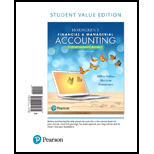
Concept explainers
(1)
Accounts receivable refers to the amounts to be received within a short period from customers upon the sale of goods and services on account. In other words, accounts receivable are amounts customers owe to the business. Accounts receivable is an asset of a business.
Bad debt expense:
Bad debt expense is an expense account. The amounts of loss incurred from extending credit to the customers are recorded as bad debt expense. In other words, the estimated uncollectible accounts receivable are known as bad debt expense.
Allowance method:
It is a method for accounting bad debt expense, where uncollectible accounts receivables are estimated, and recorded at the end of particular period. Under this method,
Write-off:
Write-off refers to deduction of a certain amount from accounts receivable, when it becomes uncollectible.
To journalize: The given transactions using allowance method.
(2)
the ending balance of accounts receivable, allowance for bad debts, and bad debt expense using T-account.
(3)
To show: The way of reporting accounts receivable on the
Trending nowThis is a popular solution!

Chapter 8 Solutions
Horngren's Financial & Managerial Accounting, The Managerial Chapters, Student Value Edition Plus MyLab Accounting with Pearson eText -- Access Card Package (6th Edition)
- Sin Carter's start-up business is growing rapidly, but he needs $300,000 in additional funding to support continued expansion. Sin and an angel investor agree that the business is currently worth $1,200,000, and the angel investor is willing to invest the $300,000 needed. Sin currently owns all 60,000 shares in his business. What is a fair price per share, and how many additional shares must Sin sell to the angel investor?arrow_forwardNonearrow_forwardOn March 1, 2024, Eastlake Corporation, which uses the straight-line method, purchases equipment for $95,000. The company expects the equipment to last for 10 years and expects the equipment to have a residual value of $15,000. What is the annual depreciation rate? a. 8.42% b. 8.95% c. 10.00% d. 12.67%arrow_forward
- Required: Management has requested that you do the following: a. Prepare a traditional income statement. b. Prepare an activity-based income statement. Complete this question by entering your answers in the tabs below. Required A Required B Prepare a traditional income statement. Traditional Income Statement Required A Required B Prepare an activity-based income statement. Costs Unit Batch Activity-Based Income Statement Resources Used Unused Resource Capacity Resources Supplied $ 0 $ 0 $ 0 0 $ 0 $ 0 Product and customer sustaining $ 0 $ 0 $ 0 Capacity sustaining $ 0 $ 0 $ 0 Total costs 0 0 0 $ Total costsarrow_forwardProvide answerarrow_forwardi need help making a T-accountarrow_forward

 AccountingAccountingISBN:9781337272094Author:WARREN, Carl S., Reeve, James M., Duchac, Jonathan E.Publisher:Cengage Learning,
AccountingAccountingISBN:9781337272094Author:WARREN, Carl S., Reeve, James M., Duchac, Jonathan E.Publisher:Cengage Learning, Accounting Information SystemsAccountingISBN:9781337619202Author:Hall, James A.Publisher:Cengage Learning,
Accounting Information SystemsAccountingISBN:9781337619202Author:Hall, James A.Publisher:Cengage Learning, Horngren's Cost Accounting: A Managerial Emphasis...AccountingISBN:9780134475585Author:Srikant M. Datar, Madhav V. RajanPublisher:PEARSON
Horngren's Cost Accounting: A Managerial Emphasis...AccountingISBN:9780134475585Author:Srikant M. Datar, Madhav V. RajanPublisher:PEARSON Intermediate AccountingAccountingISBN:9781259722660Author:J. David Spiceland, Mark W. Nelson, Wayne M ThomasPublisher:McGraw-Hill Education
Intermediate AccountingAccountingISBN:9781259722660Author:J. David Spiceland, Mark W. Nelson, Wayne M ThomasPublisher:McGraw-Hill Education Financial and Managerial AccountingAccountingISBN:9781259726705Author:John J Wild, Ken W. Shaw, Barbara Chiappetta Fundamental Accounting PrinciplesPublisher:McGraw-Hill Education
Financial and Managerial AccountingAccountingISBN:9781259726705Author:John J Wild, Ken W. Shaw, Barbara Chiappetta Fundamental Accounting PrinciplesPublisher:McGraw-Hill Education





